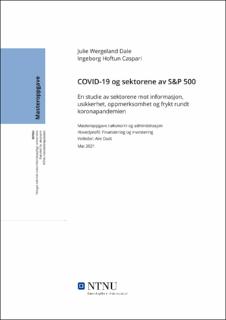| dc.contributor.advisor | Oust, Are | |
| dc.contributor.author | Caspari, Ingeborg Hoftun | |
| dc.contributor.author | Dale, Julie Wergeland | |
| dc.date.accessioned | 2021-09-22T16:05:52Z | |
| dc.date.available | 2021-09-22T16:05:52Z | |
| dc.date.issued | 2021 | |
| dc.identifier | no.ntnu:inspera:82752696:83729140 | |
| dc.identifier.uri | https://hdl.handle.net/11250/2780524 | |
| dc.description.abstract | Denne masteroppgaven undersøker hvordan de ulike sektorene av S&P 500 har reagert på COVID-19 pandemien i løpet av 2020. Vi ønsker med vår studie å undersøke hvilke variabler som kan representere pandemien, samt å få en dypere innsikt i hvordan investorer reagerer på informasjon i en tid preget av usikkerhet. Problemstillingen lyder som følgende:
Hvordan har de ulike sektorene av S&P 500 reagert på COVID-19 gjennom året 2020?
For å besvare problemstillingen, kjøres daglige og ukentlige tidsserieregresjoner for 2020, samt en analyseperiode fra 2016 til 2019. Vi benytter antall nye smittede i USA som et mål på informasjon om pandemien og dens påvirkning på økonomien. Videre undersøker vi hvorvidt usikkerhet, oppmerksomhet og frykt tilknyttet pandemien, har hatt effekt på de ulike sektorene. Disse momentene gjøres målbare i form av ulike googlesøk som vi mener representerer pandemien. Søkeordene som benyttes i studien er «Coronavirus», «COVID-19», «Coronavirus symptoms», «Coronavirus update», «Unemployment», «Quarantine» og «Lockdown». Vi inkluderer også VIX-indeksen som et mål på frykt i deler av analysen.
Vi benytter S&P 500 som en referanseindeks for aksjemarkedet. Denne er inndelt i elleve sektorer, og meravkastningene i hver enkelt sektor utgjør de avhengige variablene i våre analyser. 4-faktormodellen til Carhart (1997) og 5-faktormodellen til Fama & French (2015) brukes som utgangspunkt for våre regresjonsmodeller. I tillegg er oljepris og valuta inkludert som forklaringsvariabler.
Våre resultater indikerer at sektorene har reagert positivt men ikke signifikant på endring i amerikanske smittetall. I tillegg ser vi en signifikant negativ og positiv reaksjon av googlesøk, avhengig av hvilke sektor og søk som analyseres. Dette indikerer at mengden usikkerhet, oppmerksomhet og frykt i markedet, fungerer som et godt mål på hvordan de ulike sektorene har reagert på COVID-19, mens smittetall ikke gjør det. Det drøftes rundt muligheten for at smittetall påvirker mer indirekte i form av nedstengning, økt arbeidsledighet og hjemmekontor, som videre påvirker økonomien og aksjemarkedet. Vi analyserer våre funn med bakgrunn i teori om markedseffisiens, atferdsfinans og følelser, men vi kan ikke bevise eller konkludere noe rundt dette. Vi konkluderer med at sektorene av S&P 500 har reagert på COVID-19 gjennom økt usikkerhet, oppmerksomhet og frykt rundt pandemien. | |
| dc.description.abstract | This master thesis examines how the various sectors of the S&P 500 have responded to the COVID-19 pandemic during 2020. With our study, we want to investigate which variables can represent the pandemic, and also gain a deeper insight into how investors react to information in a time marked by uncertainty. The main problem of this thesis is as follows:
How did the various sectors of the S&P 500 react to COVID-19 through the year 2020?
To answer the problem, daily and weekly time series regressions are run for 2020, as well as a control period from 2016 to 2019. We use the number of new cases in the US as a measure of information about the pandemic and its impact on the economy. Furthermore, we investigate whether uncertainty, attention and fear associated with the pandemic have influenced the various sectors. These aspects are measured in the form of various Google searches that we believe represent the pandemic. The keywords used in the study are "Coronavirus", "COVID-19", "Coronavirus symptoms", "Coronavirus update", "Unemployment", "Quarantine" and "Lockdown". We also include the VIX index as a measure of fear in parts of the analysis.
We use the S&P 500 as a reference index for the stock market. S&P 500 is divided into eleven sectors, and the excess returns in each sector constitute the dependent variables in our analysis. The 4-factor model of Carhart (1997) and the 5-factor model of Fama & French (2015) are used as a starting point for our regression models. In addition, oil price and currency are included as explanatory variables.
Our results indicate that the sectors have responded positive but not significantly to changes in US infection rates. We also see a significantly negative and positive reaction to Google searches, depending on which sector and searches are analysed. This indicates that the amount of uncertainty, attention and fear in the market serves as a good measure of how the various sectors have reacted to COVID-19, while infection rates do not. We discuss the possibility that new COVID-19 cases affect the stock market more indirectly in the form lockdown, increased unemployment and home office, which further affect the economy and the stock market. We analyse our findings based on theory about market efficiency, behavioural finance and feelings, but we can’t prove or conclude anything based on this. We conclude that the sectors of S&P 500 have reacted to COVID-19, through increased uncertainty, attention and fear around the pandemic. | |
| dc.language | nob | |
| dc.publisher | NTNU | |
| dc.title | COVID-19 og sektorene av S&P 500 | |
| dc.type | Master thesis | |
